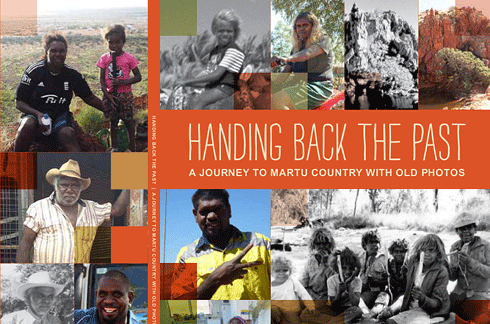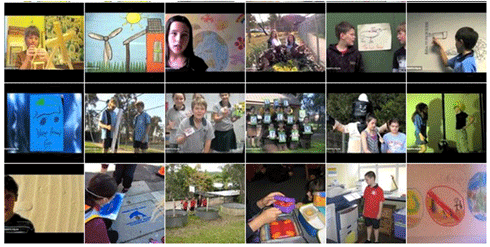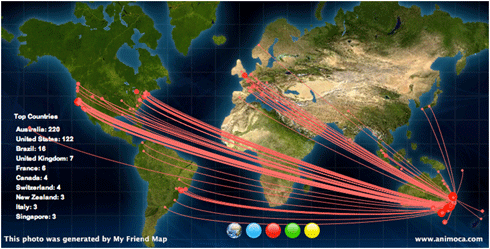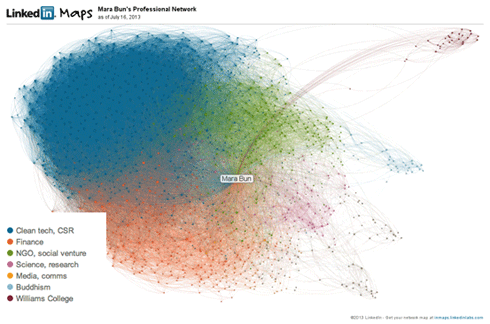
|
Published: 8 July 2013
Journey through time to Martu country
Chris McKay reviews a film that tells the engaging story of the return of a CSIRO ethno-ecologist to Martu country in remote Western Australia in 2011, to repatriate old photographs and records she assembled decades ago.

|
|
Credit: Fiona Walsh
|
Handing back the past: a journey to Martu country with old photos, a new film by CSIRO ethno-ecologist, Fiona Walsh, makes you nostalgic for a time and a place you’ve never known.
The film transports us to Australia’s Western Desert, home of the Martu people, where Fiona narrates the story of her return in 2011 to a remote Aboriginal community, Parnngurr, with a large collection of photographs she took while working there in the 1980s and 90s.
Fiona wrote, directed and produced the documentary – her first – while working on a biodiversity project involving CSIRO, WA’s Rangelands NRM and the Martu.
The establishment of Parnngurr in the 1980s was part of the ‘homelands movement’, unique in the world for bucking the emergent global trends in development.1 The Martu turned their backs on the western way of life they encountered in the missions and mining towns, and returned to live on their country, on their own terms.
Fiona arrived at Parnngurr soon after, in the 1980s, working as a junior biologist. The photos she took then capture a truly unique moment in time, a sort of renaissance for Martu culture and custom.
At the outset of the film, Fiona appears anxious about seeing what has become of the community of Parnngurr, especially the Martu, in the 20 years she had been away. How did things work out in the interim? Would anyone care about the photos? Indeed, would anyone remember her?
As Fiona points out, the repatriation of photographs to the Martu is part of a worldwide movement by museums and researchers to return past records and artefacts to Indigenous peoples. This is particularly important in Australia, where so many Aboriginal people have been displaced and separated from their families and country. Many people are actively researching their own family history, making records like this a key part of piecing their picture together.
Fiona was keen for the documentary to highlight two important ethical obligations for other researchers working with Indigenous peoples.
The first is to ensure people’s knowledge and practices are recorded accurately and in a way that is true to their local meaning and intent. The other is to ensure records, such as photos and research findings – both old and new – are shared with the people who rightfully own them, in a medium that is useful to them.
Behind the immediate account of repatriation depicted in this film lie some more subtle threads to the story. In practical terms, the plants, animals, medicines, hunting and land management techniques that were fastidiously documented by the young biologist serve as a valuable reference. It is a resource that helped the Martu with their successful Native Title claim over an area of 13 million hectares.
Nowadays, these records are used by the Martu heritage and land management organisation,
The other great story here is that of Fiona’s relationship with the Martu. The story of cross-cultural relationships between Indigenous and non-Indigenous researchers in Australia is one that often goes untold. This film gives us a rare insight into what makes them work. Fiona obviously has strong bonds with the community founded on mutual trust and respect. She fitted in comfortably with the Martu women, she says, as they shared similar interests. It’s sad to learn that the women who had adopted her as a sister in the 1980s have now passed on. They had ‘grown her up’ and taught her about that country and a way of life very different from her own.
Fiona draws heavily on the old photographs throughout the film, which is great because they are so interesting.
David Nixon, editor of the popular Bush Mechanics series and now a producer with the regional production initiative, ABC Open, has made a nice contribution with the editing and sound.
Fiona’s decision to film and document the return journey to the Martu has turned out to be a stroke of genius. She has effectively created yet another extremely valuable record of Martu life in 2011. Only this time, the story is enriched by those earlier memories.
Watch Handing back the past now:
1 The homelands movement dates back to the 1970s and was started by Aboriginal people going back onto country from mission-run larger communities because of the high level of social dysfunction and political instability that had developed in these larger communities, and to protect sacred sites and maintain customary ways of living that could only continue on country.






